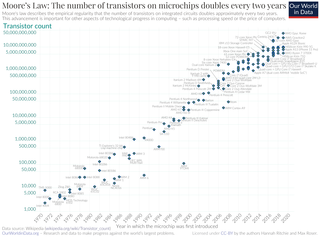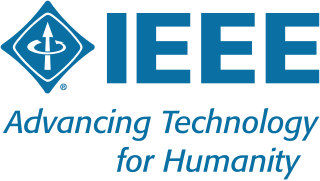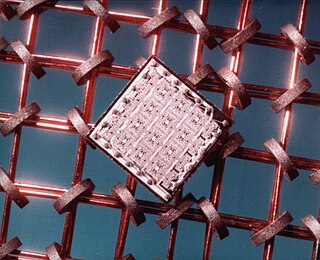
Nokia Bell Labs, originally named Bell Telephone Laboratories (1925–1984), then AT&T Bell Laboratories (1984–1996) and Bell Labs Innovations (1996–2007), is an American industrial research and scientific development company owned by Finnish company Nokia. With headquarters located in Murray Hill, New Jersey, the company operates several laboratories in the United States and around the world.

Technology is the application of knowledge for achieving practical goals in a reproducible way. The word technology can also mean the products resulting from such efforts, including both tangible tools such as utensils or machines, and intangible ones such as software. Technology plays a critical role in science, engineering, and everyday life.

Moore's law is the observation that the number of transistors in an integrated circuit (IC) doubles about every two years. Moore's law is an observation and projection of a historical trend. Rather than a law of physics, it is an empirical relationship linked to gains from experience in production.

Complementary metal–oxide–semiconductor is a type of metal–oxide–semiconductor field-effect transistor (MOSFET) fabrication process that uses complementary and symmetrical pairs of p-type and n-type MOSFETs for logic functions. CMOS technology is used for constructing integrated circuit (IC) chips, including microprocessors, microcontrollers, memory chips, and other digital logic circuits. CMOS technology is also used for analog circuits such as image sensors, data converters, RF circuits, and highly integrated transceivers for many types of communication.

The Institute of Electrical and Electronics Engineers (IEEE) is a 501(c)(3) professional association for electronics engineering, electrical engineering, and other related disciplines with its corporate office in New York City and its operations center in Piscataway, New Jersey. The mission of the IEEE is advancing technology for the benefit of humanity. The IEEE was formed from the amalgamation of the American Institute of Electrical Engineers and the Institute of Radio Engineers in 1963.

The Institution of Electrical Engineers (IEE) was a British professional organisation of electronics, electrical, manufacturing, and Information Technology professionals, especially electrical engineers. It began in 1871 as the Society of Telegraph Engineers. In 2006, it changed its name to the Institution of Engineering and Technology (IET).
Analog recording is a category of techniques used for the recording of analog signals. This enables later playback of the recorded analog audio.

Gordon Earle Moore was an American businessman, engineer, and the co-founder and emeritus chairman of Intel Corporation. He proposed Moore's law which makes the observation that the number of transistors in an integrated circuit (IC) doubles about every two years.

Stevens Institute of Technology is a private research university in Hoboken, New Jersey. Founded in 1870, it is one of the oldest technological universities in the United States and was the first college in America solely dedicated to mechanical engineering. The 55-acre campus encompasses Castle Point, the highest point in Hoboken, a campus green and 43 academic, student and administrative buildings.

The history of technology is the history of the invention of tools and techniques and is one of the categories of world history. Technology can refer to methods ranging from as simple as stone tools to the complex genetic engineering and information technology that has emerged since the 1980s. The term technology comes from the Greek word techne, meaning art and craft, and the word logos, meaning word and speech. It was first used to describe applied arts, but it is now used to describe advancements and changes which affect the environment around us.

The History of Science Museum in Broad Street, Oxford, England, holds a leading collection of scientific instruments from Middle Ages to the 19th century. The museum building is also known as the Old Ashmolean Building to distinguish it from the newer Ashmolean Museum building completed in 1894. The museum was built in 1683, and it is the world's oldest surviving purpose-built museum.
Ahmad Yousef Al-Hassan was a Palestinian/Syrian/Canadian historian of Arabic and Islamic science and technology, educated in Jerusalem, Cairo, and London with a PhD in Mechanical engineering from University College London. He was Dean of Engineering and later President of the University of Aleppo where he founded the Institute for the History of Arabic Science (IHAS) and was its first director. He also served as Minister of Petroleum, Electricity and Mineral Resources of Syria prior to 1971. He migrated to Canada in 1982.

Technology and Culture is a quarterly academic journal founded in 1959. It is an official publication of the Society for the History of Technology (SHOT), whose members routinely refer to it as "T&C." Besides scholarly articles and critical essays, the journal publishes reviews of books and museum exhibitions. Occasionally, the journal publishes thematic issues; topics have included patents, gender and technology, and ecology. Technology and Culture has had three past editors-in-chief: Melvin Kranzberg (1959–1981), Robert C. Post (1982–1995), and John M. Staudenmaier (1996–2010). Since 2011 the journal has been edited at the University of Oklahoma by Suzanne Moon. Managing editors have included Joan Mentzer, Joseph M. Schultz, David M. Lucsko, and Peter Soppelsa.

The Journal of Military History is a quarterly peer-reviewed academic journal covering the military history of all times and places. It is the official journal of the Society for Military History. The journal was established in 1937 and the editor-in-chief is Bruce Vandervort. It is abstracted and indexed in the Arts & Humanities Citation Index and Current Contents/Arts & Humanities.
Science and technology in Asia is varied depending on the country and time. In the past, among Asian civilizations considered particularly notable for their contributions to science and technology were India, China and the West Asian civilizations. Countries such as Japan, South Korea, and Taiwan are recently known for technology, while China and India are also major contributors to science and technology. Other countries are also notable in other scientific fields such as chemical and physical achievements. For the science and technology of various Asian countries and civilizations, see:

Periyar Maniammai Institute of Science & Technology (PMIST), formerly Periyar Maniammai College of Technology for Women and Periyar Maniammai University (PMU), is a private deemed-to-be-university headquarters is in the town of Vallam in Thanjavur, Tamil Nadu, India. The campus is on 216 acres (87 ha) 45 km (28 mi) east of Tiruchirapalli and 10 km (6.2 mi) west of Thanjavur.

Lost Worlds is a documentary television series by The History Channel that explores a variety of "lost" locations from ancient to modern times. These "great feats of engineering, technology, and culture" are revealed through the use of archaeological evidence, interviews with relevant experts while examining the sites, and CGI reproductions. These visual re-creations take the form of rendered 3D environments and photo manipulated overlays, allowing the "lost world" to be seen over its present-day state.

A dystopia is a speculated community or society that is undesirable or frightening. It is often treated as an antonym of utopia, a term that was coined by Sir Thomas More and figures as the title of his best known work, published in 1516, which created a blueprint for an ideal society with minimal crime, violence, and poverty. The relationship between utopia and dystopia is in actuality, not one simple opposition, as many utopian elements and components are found in dystopias as well, and vice versa.

Random-access memory is a form of computer memory that can be read and changed in any order, typically used to store working data and machine code. A random-access memory device allows data items to be read or written in almost the same amount of time irrespective of the physical location of data inside the memory, in contrast with other direct-access data storage media, where the time required to read and write data items varies significantly depending on their physical locations on the recording medium, due to mechanical limitations such as media rotation speeds and arm movement.
Information technology (IT) is the use of computers to create, process, store, retrieve and exchange all kinds of data and information. IT forms part of information and communications technology (ICT). An information technology system is generally an information system, a communications system, or, more specifically speaking, a computer system — including all hardware, software, and peripheral equipment — operated by a limited group of IT users.
















